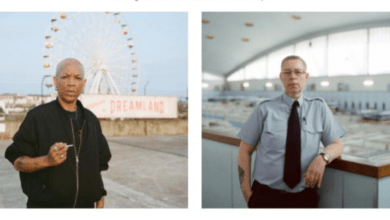Claud Cahun, born Lucy Renee Mathilde Schwob, was one of many creative lesbians who change their names to something more androgynous sounding in the first half of the twentieth century. Along with writer Radclyffe Hall, and artists Romaine Brooks and Gluck, Claud took a stand against the feminine expectations enforced on females by choosing a name that strayed from the traditional take on womanhood.

Claud, who was Jewish, and her lifelong partner, Marcel Moore (born Suzanne Malherbe), were two lesbian artists who used their creativity, love and wit to fight gender, circumstances, and Nazis.
Fighting Gender Stereotypes
Her androgyny is not proof she didn’t see herself as a woman. Claud pushed against the expectations enforced on women and chose to live authentically, as herself. Femininity is taught to girls and, historically, the more “feminine” the performance — depending on what’s considered “feminine” at the time — the more “womanly” and “beautiful” the girl becomes.
Claud changing her name to sound more androgynous to the public — while still using “Lucy” at home and around friends and relatives — was an expression of resisting patriarchal ideas about women. She didn’t care to be seen as “beautiful” — like the feminine name “Lucy” connotes — but that doesn’t mean she didn’t see herself as a woman.
Claude, and other brave Modernist lesbians, acknowledged the difference between gender expectations and being a member of the female sex. Gender is the set of stereotypes attributed to a person’s sex. Choosing not to conform to the stereotypes – refusing to hide who she really was for social acceptance – doesn’t make Claud any less Woman, and it’s offensive to say so. People have, though.
During the 1990s – and with the rise of queer theory – a fresh spotlight was put on Claud’s work. Claud was dislocated from womanhood due to her disapproval of our feminine conditioning by many contemporary art historians and scholars, who viewed her resistance to femininity as a sign she didn’t “identify” as a woman.
The growing theory wasn’t (and isn’t) far from traditional, patriarchal views: womanhood is femininity, rather than the reality of being female, to queer theorists. Therefore, any woman who doesn’t relate to or express the expectations of femininity must not be a woman and, therefore, has the option to identify out of her sex. Even if a woman didn’t identify out of her sex, then it’s okay we assume she did posthumously… apparently.
Claud even wrote about upending conventions on purpose. The expectations were, and are, the issue, not being a woman. “My role was to embody my own revolt and to accept, at the proper moment, my destiny, whatever it may be,” she wrote. If womanhood is “feeling” feminine then most women aren’t women. We express femininity because we’re socialized to, it’s expected of us, not because it’s in our nature to do so. Claud knew she was bucking the system. Calling her “man-like” for doing so makes you someone she revolted against.

Claud Cahun was a boundary-pushing artist. Joseph B. Treaster writes about her photographs for the NY Times, “Here she’s a man. There she’s a woman. Sometimes she’s a little of both.” That perception could only be formed out of seeing men as masculine and women as feminine. Isn’t it possible that a woman can shave her head, resist femininity, and not be “manly?” Why don’t we say the same about Britney Spears, who shaved her head in 2007? Is Claud’s “gender identity” up for debate because she was a lesbian?
Fighting Circumstance
I confidently call Claud Cahun a lesbian because she had one lifelong partnership and it was with a woman, Marcel Moore (born Suzanne Alberte Maherbe). There’s also the evidence of homosexuality, and lack of evidence she was attracted to men. Many lesbians at the time, and still today, took male partners before they discovered their true sexual orientation. Claud didn’t.
Many of us think we are straight until proven otherwise. We realize we see men differently to our straight friends. We feel for males platonically, and it usually takes falling for a woman to understand what we can’t and don’t feel for men. However, Claud met Marcel before she hit 18. There wasn’t anyone else.

Marcel and Claud’s love story is unique. Claud, or Lucy, was sent to boarding school in England when she was 12 after her French classmates harassed her for being Jewish. At around 15, Claud met Marcel (Suzanne). Claud wrote that it was like a lightning strike.
Claud’s father married Marcel’s mother, Marie, eight years later. Claud and Marcel were already committed to each other, but being viewed as “step-sisters” to the public gave them more autonomy in their relationship. They lived together in Paris, like many other modernist lesbians who migrated to the comparatively liberal city, and the couple lived comfortably off family funds.
Claud and Marcel made their home a safe haven for artists, writers, and ideas people. Here “they talked about social justice and debated communism as a counterforce to fascism,” according to the NY Times. André Breton, a leader of the Surrealist movement, wrote in a letter to Claud Cahun in the early 1930s that she was “one of the most curious spirits of our time.”
Claud never exhibited her art, which involved Marcel’s input and inspiration as much as it did Claud’s. “They were a mode of investigation, who you could be, how you could be, projecting yourself into another skin, another universe,” said Tirza True Latimer, who wrote about Claud in her ph.D. thesis twenty years ago. “These were two lesbians living within certain constraints. The photographs, the acting out, were a way of being free. It wasn’t really about producing an art object.”
Fighting Nazis
Claud and Marcel moved to Jersey in 1937, as tensions rose in prewar Paris. The Nazis steamrolled France in 1940, including Jersey. “Claud and Moore fought back – with their typewriter and pens, writing short messages to the Germans under the guise of an unhappy soldier they called “the soldier with no name,” according to the NY Times.
The messages were written on small bits of paper, including toilet paper. They read “the war [is] lost” and German troops should “look out for themselves.” They called Hitler a “vampire.” One note read, “Nobody dies for us.” The notes were slipped “into uniform pockets at the laundry, under windshield wipers and into cigarette packs left on cafe tables.”
The effort had serious consequences. Claud and Marcel “had a suicide plan and carried barbiturates. After three years they were caught and sentenced to death. Twice, they tried to kill themselves but underdosed. The war ended and they went free.”
Claud’s health suffered during their wartime imprisonment. She died in 1954, nine years after their release, without much notice. Marcel Moore was buried with Claud, after spending twenty years without her, when she committed suicide in 1972. “They are now together under a single gravestone inscribed with two Stars of David and their birth names.”
They decided not to use their chosen names, Claud Cahun and Marcel Moore, on their gravestone, which might seem like a mystery to many. The pair used their birth names, Lucy and Suzanne, around people they trusted, so engraving those names makes perfect sense to anybody who sees the pair as two incredibly creative lesbians who spent their lives on the run from antisemitism, misogyny, lesbophobia and fascism. They used art to create personas, to perform, to investigate, to shield (and fight), and they survived for as long as they did through the life-long love they had for each other.





